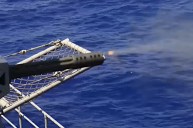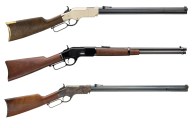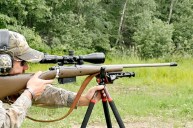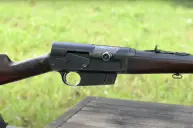The Mauser Tankgwehr 1918 anti-tank rifle was one of the first of its kind.
Military history is rife with firearms experiments that have been developed quickly out of pure necessity on the battlefield. One of those guns is the slightly obscure Mauser Tankgewehr M1918 or "T-Gewehr" for short. In a way, this massive 5-foot, 7-inch, 35-pound, rifle was sort of the great grandfather for modern anti-material rifles like the Barrett .50 BMG.
In the first World War, Germany was taken by surprise when some of the first-ever tanks began rolling onto the battlefield during the bloody trench warfare. Tank crews were protected by crude armor that was not nearly as effective as what is used today.
As a result, the German army realized they could produce an armor-piercing bolt-action rifle quickly and efficiently by essentially building a bigger version of a traditional Mauser action chambered for massive 13.2mm rounds. That made this gun the world's first anti-tank rifle. See this incredible firearm in action in the video below.
We are sure you probably already noticed, but there is no muzzle brake, nor a recoil pad on the Mauser 1918 T-Gewehr. The pistol grip is an interesting feature since that's not something typically associated with long guns from 100 years ago. As far as anti-material rifles go, it's quite crude with those iron sights and simplistic bipod. We did a little research and found the effective range was a little over 500 yards. That's nothing for some of today's modern rifles, but for the only anti-tank rifle in WWI, that was no doubt an impressive range.
This single-shot was clearly not something designed for a high rate of fire. The comfort of the shooter was also not a big concern for the Germans in World War I. They cared more about simply getting the anti-tank weapon into mass production and to the WWI battlefields where it was needed.
It is interesting to note here that the Germans were working on another anti-tank weapon around this same time. That project was the MG 18 TuF machine gun. TuF stands for "tank und flieger," meaning it was a round for both tanks and aircraft. The development of this firearm proved difficult however and the 13x92mm TuF cartridge gun never got quite past the developmental stage before the war ended in 1918.
Post-war treaties ended the use of Mauser Tankgewehr M1918 anti-tank rifle in later conflicts like World War II and halted the development of the MG 18, which we would say was a good thing for world history. Today, this firearm remains a somewhat forgotten oddity of world history. It's certainly fascinating to look at and see in action though isn't it? Our shoulders hurt just thinking about firing this beast today!
Products featured on Wide Open Spaces are independently selected by our editors. However, when you buy something through our links, we may earn a commission.
NEXT: THE AXIS DEER AND HOW THEY'RE IMPACTING PARTS OF THE UNITED STATES





